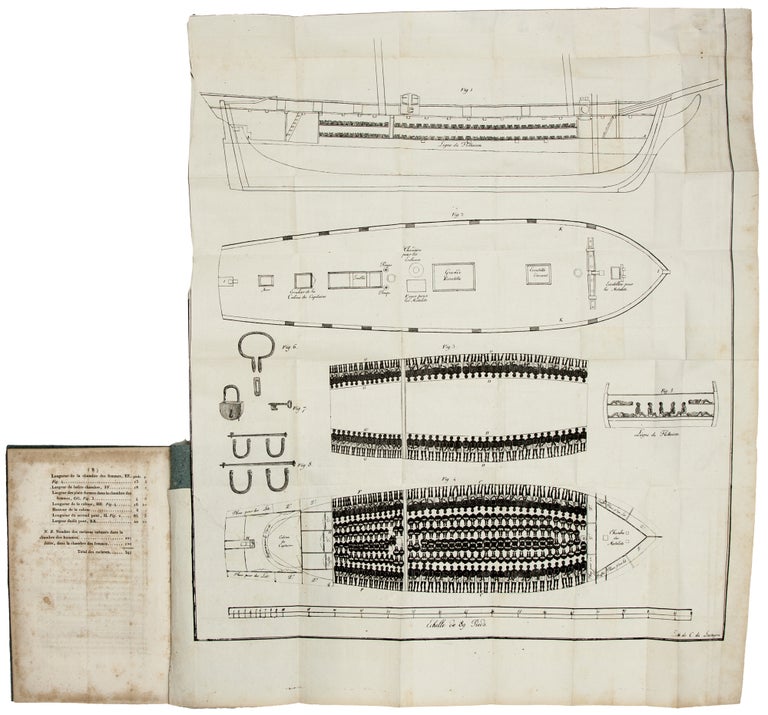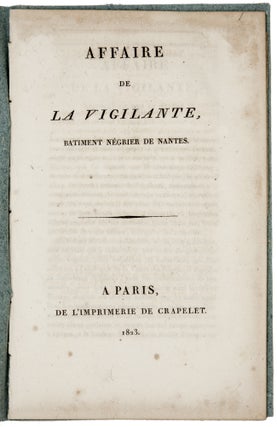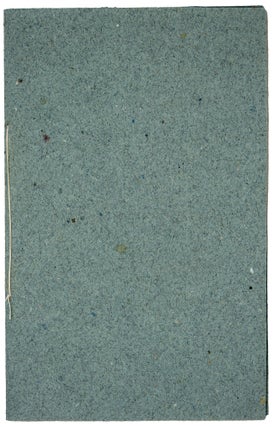Affaire de la Vigilante, batiment négrier de Nantes.
8vo, (1) f (=title page), pp. 1-8. With a folding lithographic plate by Charles-Philibert de Lasteyrie. The image is 50 x 42 cm with margins on bottom and right. In blue paper wrapper. Plate with minor repair not affecting image. With some foxing, especially around the margins. Generally very good. "A rare untranslated, original work in French documenting the slave trade--not merely reproducing and translating Clarkson or other English abolitionists" (Miller, p. 172). In this abolitionist pamphlet, the anonymous author describes the capture of La Vigilante, a French vessel from Nantes employed in the slave trade. It was apprehended by the British on April 15, 1822, off the coast of Africa. The boat had 345 slaves on board, who were found lying on their backs as well as seated on the lower deck, with chains around their necks, feet, and arms. The horrific predicament of the slaves is pictured in the lithograph, accompanying the pamphlet. Tonnerre-Seychelles suggests in her essay that the brochure was written by La Société de la morale chrétienne [Society of Christian Morals], of which the lithographer of this plate, Charles-Philibert de Lasteyrie, was a founding member. Once the ship was captured, "the British lieutenant, with the poetic name of Mildmay, removed a ten-foot-long chain from a twelve-year-old slave girl and clamped it on the ankle of her captor, the French captain of La Vigilante" (Miller, p. 172). That day, patrolling the waters of Bony River, Mildmay and his crew apprehended five more ships, including two Spanish schooners, French brigantine and two bricks. The surviving slaves were liberated and brought to Sierra Leone, the colony of liberated captives, where they found "with freedom all the necessary facilities in order to instruct themselves about everything concerned with agriculture and trades" (pp. 4-5). The French National Convention had voted to abolish slavery in the colonies in 1794--a decision later repealed by Napoleon Bonaparte. In 1818, France banned the slave trade in the country, but the abolition of slavery in the French colonies would not be proclaimed until 1848. According to Miller, the abolitionist movement never achieved broad popular support in France during the Restoration. He attributes it partially to government censorship of antislavery publications and to Anglophobia ("abolition of the slave trade was, after all, associated in the minds of Frenchmen with Napoleon's defeat and with a British thirst for hegemony" (Miller, p. 196)). The anonymous author of L'Affaire de la Vigilante suggests that "only ignorance of the facts can explain the tepid nature of [French] opinion on this question" (p. 6). The print depicts the longitudinal section of the ship (Fig. 1), a plan of the upper deck (Fig. 2) a plan of the wings (Fig. 3), a plan of the lower deck (Fig. 4), as well as a transverse section of the ship from the water line upward, showing the positions of the slaves (Fig. 5). Also illustrated are an iron collar found on the neck of the slaves (Fig. 6), a padlock to the neck collar (Fig. 7) and iron fetters put on the arms and legs of the slaves (Fig. 8). A two-page explanatory key (pp. 7-8) accompanies the lithograph.
Price: $6,500.00



